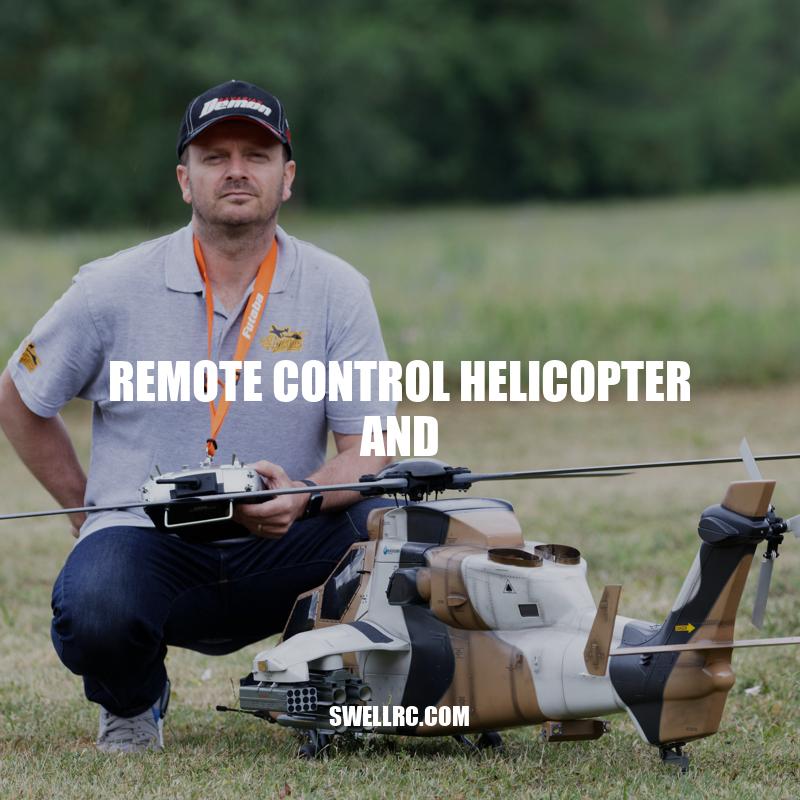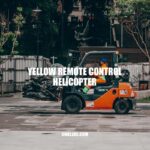Remote Control Helicopters: Everything You Need to Know
Remote control helicopters have become increasingly popular in recent years, thanks to advancements in technology and accessibility. The idea of flying a miniature helicopter using a remote control may seem daunting, but it’s a hobby that has something to offer everyone. Remote control helicopters can be used for recreational purposes, such as flying in a park, or even for aerial photography and videography. They are available in a variety of sizes, ranging from small indoor models to larger outdoor models. This means that there is a remote control helicopter for every skill level, whether you’re a beginner or an experienced pilot. One of the benefits of owning a remote control helicopter is that it provides a unique perspective on the world, allowing you to see sights from a bird’s-eye view. With enough practice and patience, anyone can develop the skills necessary to control a remote control helicopter with precision and grace.
Types of Remote Control Helicopters
There are two main types of remote control helicopters: electric and gas-powered. Each type has its own unique set of advantages and disadvantages. Here are some points to consider when choosing between an electric and gas-powered remote control helicopter:
- Electric Remote Control Helicopters:
- Ideal for beginners because they are easier to operate
- Easier to maintain since they don’t require fuel or oil
- Quieter and more environmentally-friendly than gas-powered helicopters
- Shorter flight time, typically around 10-15 minutes per battery charge
- Gas-Powered Remote Control Helicopters:
- More complex but offer more power and longer flight times
- Typically have a flight time of around 20-30 minutes per tank of fuel
- Provide a greater sense of realism since they mimic the mechanics of full-scale helicopters
- More expensive to operate since they require special fuel and regular maintenance
Another factor to consider when choosing a remote control helicopter is whether you plan to fly it indoors or outdoors. Indoor models are typically smaller and more lightweight, making them better suited for flying in small spaces. Outdoor models, on the other hand, are larger and more powerful, which makes them better suited for flying in larger open spaces. If you’re new to the world of remote control helicopters, it’s recommended that you start with an electric indoor model to get a feel for the mechanics before moving on to more complex gas-powered outdoor models.
Where to Buy Remote Control Helicopters
If you’re in the market for a remote control helicopter, there are many websites and brick-and-mortar stores that sell them. Some popular online retailers include Amazon, HobbyKing, and Horizon Hobby. These sites offer a wide range of remote control helicopters at competitive prices. Additionally, you can often find local hobby shops that specialize in remote control helicopters and other types of model aircraft. These shops can provide valuable advice and support when it comes to choosing the right remote control helicopter and accessories.
What are remote control helicopters called?
Remote control helicopters, also known as RC helicopters, are a fascinating type of model aircraft that have become increasingly popular in recent years. They are very different from RC airplanes in terms of construction, aerodynamics, and flight training, and offer a unique and exciting flying experience.
Radio-controlled helicopters use a remote control device to control their movements, and can be flown both indoors and outdoors. They come in a variety of sizes, from miniature models that can be flown inside a living room, to larger models that are used for professional aerial photography and other applications.
One of the main differences between RC helicopters and RC airplanes is their construction. RC helicopters are more complex in terms of their mechanics and design, with multiple rotors and a more advanced control system. This allows them to perform maneuvers that are impossible for RC airplanes, such as hovering in place, flying upside down, and performing complex aerobatic maneuvers.
Another key difference is the level of skill required to fly them. RC helicopter pilots must undergo extensive training and practice to master the complex controls and aerodynamics, while RC airplane pilots can often learn to fly with relative ease.
In spite of the challenges, flying RC helicopters can be an incredibly rewarding hobby that offers a unique perspective on the world around us. Whether you’re a seasoned pro or just starting out, there’s nothing quite like the thrill of watching your little helicopter take to the skies and soar through the air with grace and ease.
Components of Remote Control Helicopters
To better understand how to fly a remote control helicopter with precision, it’s important to familiarize yourself with the components of the device. Here are the main components of a remote control helicopter:
| Component | Description |
|---|---|
| Main Rotor | The large rotor blade(s) that provide lift and control the helicopter’s forward and backward movements. |
| Tail Rotor | A smaller rotor blade that provides anti-torque control and allows for rotation of the helicopter around its own axis. |
| Gyro | A device that helps keep the helicopter level and reduces the risk of crashes by making adjustments to the tail rotor as needed. |
| Servos | Devices that control the movement of the main rotor and tail rotor. They receive signals from the transmitter and make corresponding adjustments to the rotor blades. |
In addition to these main components, some advanced remote control helicopters may also feature additional components such as a stabilizer bar, flybarless system, or brushless motor. These components can help improve stability and performance during flight.
Here are some facts about the components of remote control helicopters:
- The main rotor of a remote control helicopter is typically made from lightweight materials such as carbon fiber or plastic to reduce weight and improve maneuverability.
- Tail rotors are also known as anti-torque rotors, and help counteract the force produced by the main rotor as it spins.
- As technology has advanced, gyros have become more advanced and can now make thousands of adjustments per second to keep the helicopter level during flight.
If you’re in the market for a remote control helicopter, it’s important to choose one that includes high-quality components. Some well-regarded manufacturers of remote control helicopters include Blade, Align, and Thunder Tiger. These manufacturers offer a wide range of models and parts, as well as helpful resources such as instructional videos and user forums.
What are all the parts of a remote control helicopter?
Remote control helicopters are a popular hobby for many enthusiasts. These miniature flying machines are made up of various parts that work together for smooth operation. If you have ever been curious about the parts that go into making a remote control helicopter, then you are in the right place!
The key components of a remote control helicopter are the rotor hub, main rotor, swash plate, tail servo, tail boom, tail rotor, and landing skid. These parts are responsible for ensuring that the helicopter stays in the air and can be maneuvered easily.
The rotor hub is the central hub that connects the main rotor blades to the helicopter’s body. The main rotor is responsible for generating lift and keeping the helicopter in the air. The swash plate is the part that translates the movements of the remote control into movements of the main rotor blades.
The tail servo is responsible for controlling the tail rotor, which is used to provide directional control for the helicopter. The tail boom is the long tube that extends from the back of the helicopter and on which the tail rotor sits. Lastly, the landing skid provides a stable platform for the helicopter to land on and helps prevent damage to the body and other parts.
All of these parts work together to make a remote control helicopter fly and be controlled effectively. With the right combination of parts and skilled operation, remote control helicopters can be flown indoors or outdoors for hours of entertainment. Check out Figure 2 for a demonstration of the main parts of a remote control helicopter!
Practice Makes Perfect
Flying a remote control helicopter requires practice and patience. It’s important to start with the basics before moving on to more complex maneuvers. Here are some tips to improve your skills as a remote control helicopter pilot:
- Start by practicing hovering, which involves keeping the helicopter in a stationary position in the air. This will help you get used to controlling the helicopter’s up and down movements.
- Once you’re comfortable with hovering, move on to simple turns. Start with small turns and gradually increase the angle to master tighter turns.
- After mastering basic turns, try more complex maneuvers such as figure eights and circles. These maneuvers will help you get comfortable with maneuvering in different directions.
- As you become more skilled, you can try more advanced moves such as flips and rolls. These require more practice and may take some time to master.
- Always fly your helicopter in a safe and open area, away from people and obstacles. Avoid flying in windy conditions, as this can make it difficult to control the helicopter.
With regular practice and patience, anyone can become a skilled remote control helicopter pilot. It’s important to remember that accidents can happen, and crashes are inevitable. Be sure to have spare parts on hand and familiarize yourself with repair processes, as some repairs can be done at home.
In conclusion, remote control helicopters are a thrilling hobby that anyone can enjoy with a bit of practice and patience. By familiarizing yourself with the components of your helicopter, practicing basic maneuvers, and prioritizing safety, you can become a skilled remote control helicopter pilot in no time.



